
Tesseract
Did you know...
This wikipedia selection has been chosen by volunteers helping SOS Children from Wikipedia for this Wikipedia Selection for schools. Sponsoring children helps children in the developing world to learn too.
| Tesseract (8-cell) 4-cube |
|
|---|---|
 Schlegel diagram |
|
| Type | Regular polychoron |
| Family | hypercube |
| Cells | 8 (4.4.4) |
| Faces | 24 {4} |
| Edges | 32 |
| Vertices | 16 |
| Vertex figure | (3.3.3) |
| Schläfli symbols | {4,3,3} {4,3}x{} {4}x{4} {4}x{}x{} {}x{}x{}x{} |
| Coxeter-Dynkin diagrams | |
| Symmetry group | B4, [3,3,4] |
| Dual | 16-cell |
| Properties | convex |
In geometry, the tesseract, also called 8-cell or octachoron, is the four-dimensional analog of the cube, which is in turn the three dimensional analog of the square. The tesseract is to the cube as the cube is to the square; or, more formally, the tesseract can be described as a regular convex 4-polytope whose boundary consists of eight cubical cells.
A generalization of the cube to dimensions greater than three is called a “ hypercube”, “n-cube” or “measure polytope”. The tesseract is the four-dimensional hypercube or 4-cube.
According to the Oxford English Dictionary, the word tesseract was coined and first used in 1888 by Charles Howard Hinton in his book A New Era of Thought, from the Greek “τέσσερεις ακτίνες” (“four rays”), referring to the four lines from each vertex to other vertices. Some people have called the same figure a “tetracube”, and also simply a "hypercube" (although a hypercube can be of any dimension).
Geometry
The tesseract can be constructed in a number of different ways. As a regular polytope constructed by three cubes folded together around every edge, it has Schläfli symbol {4,3,3}. Constructed as a 4D hyperprism made of two parallel cubes, it can be named as a composite Schläfli symbol {4,3}x{ }. As a duoprism, a Cartesian product of two squares, it can be named by a composite Schläfli symbol {4}x{4}.
Since each vertex of a tesseract is adjacent to four edges, the vertex figure of the tesseract is a regular tetrahedron. The dual polytope of the tesseract is called the hexadecachoron, or 16-cell, with Schläfli symbol {3,3,4}.
The standard tesseract in Euclidean 4-space is given as the convex hull of the points (±1, ±1, ±1, ±1). That is, it consists of the points:
A tesseract is bounded by eight hyperplanes (xi = ±1). Each pair of non-parallel hyperplanes intersects to form 24 square faces in a tesseract. Three cubes and three squares intersect at each edge. There are four cubes, six squares, and four edges meeting at every vertex. All in all, it consists of 8 cubes, 24 squares, 32 edges, and 16 vertices.
Projections to 2 dimensions
The construction of a hypercube can be imagined the following way:
- 1-dimensional: Two points A and B can be connected to a line, giving a new line AB.
- 2-dimensional: Two parallel lines AB and CD can be connected to become a square, with the corners marked as ABCD.
- 3-dimensional: Two parallel squares ABCD and EFGH can be connected to become a cube, with the corners marked as ABCDEFGH.
- 4-dimensional: Two parallel cubes ABCDEFGH and IJKLMNOP can be connected to become a hypercube, with the corners marked as ABCDEFGHIJKLMNOP.
This structure is not easily imagined but it is possible to project tesseracts into three- or two-dimensional spaces. Furthermore, projections on the 2D-plane become more instructive by rearranging the positions of the projected vertices. In this fashion, one can obtain pictures that no longer reflect the spatial relationships within the tesseract, but which illustrate the connection structure of the vertices, such as in the following examples:
A tesseract is in principle obtained by combining two cubes. The scheme is similar to the construction of a cube from two squares: juxtapose two copies of the lower dimensional cube and connect the corresponding vertices. Each edge of a tesseract is of the same length. A multitude of cubes that are nicely interconnected. The vertices of the tesseract with respect to the distance along the edges, with respect to the bottom point. This view is of interest when using tesseracts as the basis for a network topology to link multiple processors in parallel computing: the distance between two nodes is at most 4 and there are many different paths to allow weight balancing.
Tesseracts are also bipartite graphs, just as a path, square, cube and tree are.
Projections to 3 dimensions
The cell-first parallel projection of the tesseract into 3-dimensional space has a cubical envelope. The nearest and farthest cells are projected onto the cube, and the remaining 6 cells are projected onto the 6 square faces of the cube.
The face-first parallel projection of the tesseract into 3-dimensional space has a cuboidal envelope. Two pairs of cells project to the upper and lower halves of this envelope, and the 4 remaining cells project to the side faces.
The edge-first parallel projection of the tesseract into 3-dimensional space has an envelope in the shape of a hexagonal prism. Six cells project onto rhombic prisms, which are laid out in the hexagonal prism in a way analogous to how the faces of the 3D cube project onto 6 rhombs in a hexagonal envelope under vertex-first projection. The two remaining cells project onto the prism bases.
The vertex-first parallel projection of the tesseract into 3-dimensional space has a rhombic dodecahedral envelope. There are exactly two ways of decomposing a rhombic dodecahedron into 4 congruent parallelepipeds, giving a total of 8 possible parallelepipeds. The images of the tesseract's cells under this projection are precisely these 8 parallelepipeds. This projection is also the one with maximal volume.
Unfolding the tesseract
The tesseract can be unfolded into eight cubes, just as the cube can be unfolded into six squares. An unfolding of a polytope is called a net. There are 261 distinct nets of the tesseract. The unfoldings of the tesseract can be counted by mapping the nets to paired trees (a tree together with a perfect matching in its complement).
Tesseracts in popular culture
Books/print
- Madeline L'Engle's novel A Wrinkle in Time uses tesseracts as a way for Meg Murry and her companions to travel to other planets and dimensions, however the description more closely matches a wormhole.
- Carl Sagan describes the tesseract in great detail using layman's terms in Cosmos, episode 10.
- In Edwin A. Abbott's novel Flatland, 1884, a hypercube is imagined by the narrator.
- Robert A. Heinlein mentioned hypercubes in at least three of his science fiction stories. In “—And He Built a Crooked House—” (1940), he described a house built as a net (i.e., an unfolding of the cells into three-dimensional space) of a tesseract. It collapsed, becoming a real 4-dimensional tesseract. Heinlein's 1963 novel Glory Road included the foldbox, a hyperdimensional packing case that was bigger inside than outside.
- Hypercubes and all kinds of multi-dimensional space and structures star prominently in many books by Rudy Rucker.
- A hypercube is used as the main deus ex machina of Robert J. Sawyer's book Factoring Humanity, even appearing on its North American cover.
- Piers Anthony's novel Cube Route also features a tesseract.
- Alex Garland's second book is called "Tesseract: a novel".
- The DC Comics crossover DC One Million showed a future Earth in which cities occupied extradimensional areas called tesseracts, leaving the planet's surface unspoiled. Similar technology was used for Superman's current Fortress of Solitude, and was used as storage space in the headquarters of the original incarnation (pre- Zero Hour) of the Legion of Super-Heroes.
- Ian Irvine's Sci-Fi Fantasy 'Tetrarch' Book two of the 'The Well of Echoes Quartet'.
- David Lubar's 'Sleeping Freshmen Never Lie'. Tesseract meaning "spiraling into another dimension."
- Lewis Padgett's classic short story, ' Mimsy Were the Borogoves' features two children who construct a tesseract using information from the future. They ultimately disappear into another dimension.
- Umberto Eco references tesseracts in Foucault's Pendulum
Visual arts
- The painting Crucifixion (Corpus Hypercubus), by Salvador Dalí, 1954, depicts the crucified Jesus upon the net of a hypercube. It is featured at the Metropolitan Museum of Art in New York, USA.
Television and movies
- The television program Andromeda makes use of tesseract generators as a plot device. These are primarily intended to manipulate space (also referred to as phase shifting) but often cause problems with time as well.
- A character in the television program Numb3rs shows a model of a tesseract in the second-season episode Rampage, during a discussion of using a 4-dimensional perspective to analyze an event.
- The TV programme Strange Days at Blake Holsey High has an episode where the school campus transforms into a self-folding hypercube.
- The movie Cube 2: Hypercube focuses on eight strangers trapped inside a net of connected cubes or perhaps some sort of tesseract which shifts in the direction of the 8 strangers movements in any directions, making a seemingly endless continuum of singular cubes.
- The movie The Last Mimzy mentions tesseracts in a list of other geometrical shapes when the children are dreaming about the bridge across the universe, as does the short story on which it is based, ' Mimsy Were the Borogoves' (listed above). This may also be in homage to A Wrinkle in Time.
Business
- Tesseract Books was a prominent publisher of Canadian science fiction books. The company is now an imprint of Hades Publishing Inc.
Video Games
- Starflight included a tesseract as an artifact which could be found by exploring planet surfaces.
Games
- A tesseract forms the basis of the fantasy Advanced Dungeons & Dragons module Baba Yaga's Hut, which appeared in an early issue of Dragon Magazine, with the tesseract existing as the interior of the titular Hut.




